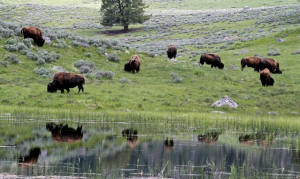|
U.S. ordered to reconsider denial of
Yellowstone bison protections
 Send a link to a friend
Send a link to a friend
 [February 02, 2018]
By Laura Zuckerman [February 02, 2018]
By Laura Zuckerman
PINEDALE, Wyo. (Reuters) - A judge has
ruled that U.S. wildlife managers erred in denying Endangered Species
Act protection to bison at Yellowstone National Park and must reconsider
extending such safeguards to America's largest pure-bred herd of wild
buffalo.
The decision was welcomed on Thursday by wildlife advocates who
petitioned the Obama administration in 2014 to protect bison in and
around Yellowstone, where animals wandering outside park boundaries are
culled for slaughter by the hundreds each year.
The seasonal culling is supported by ranchers in the region,
particularly in Montana, concerned about exposure of livestock to
disease, competition for grass and property damage from straying bison.
“This is a victory for bison,” Ken Cole, director of the Buffalo Field
Campaign, told Reuters by telephone.

Officials for the U.S. Fish and Wildlife Service said they were
reviewing the ruling, issued on Wednesday by U.S. District Judge
Christopher Cooper in the District of Columbia.
Yellowstone's herd of 4,000-plus bison constitutes the largest and one
of the last free-roaming, genetically pure groups of an animal that once
roamed North America by the millions before being hunted to near
extinction in the late 1800s.
Conservation groups have argued that endangered species status is
necessary to ensure the long-term survival of wild bison, also widely
known as buffalo, and help restore the creature to more of its historic
natural range.
The bison, a shaggy, hump-shouldered animal weighing up to 2,000 pounds
(990 kg) and standing 6 feet (1.8 meters) tall at the shoulders, was
officially designated the U.S. national mammal in 2016.
The Fish and Wildlife Service concluded in 2015 that conservation groups
had failed to present sufficient evidence that the Yellowstone buffalo
band was imperiled.
[to top of second column]
|

A herd of bison graze in Lamar Valley in Yellowstone National Park,
Wyoming, U.S. on June 20, 2011. REUTERS/Jim Urquhart/File Photo

Cooper ruled that the Interior Department agency had erroneously
failed to consider or otherwise ignored evidence indicating
Yellowstone bison may be threatened or endangered.
The ruling hinged on a scientific dispute over whether there are two
genetically distinct populations of bison at Yellowstone, known
respectively as a central herd and a northern herd. Conservationists
cited research suggesting the government’s overall target at the
park of 3,000 bison was too low to prevent extinction of one or both
of them.
Government biologists dismissed that research. But Cooper said the
Fish and Wildlife Service was required by law to explain why it
found the research irrelevant, and he ordered a new agency review of
whether Yellowstone bison merit protections.
The decision has no bearing on the estimated 160,000 head of
privately raised bison, most of them in the West and consisting
mainly of animals that carry cattle genes and are bred for
commercial production.
(Editing by Steve Gorman and Peter Cooney)
[© 2018 Thomson Reuters. All rights
reserved.]
Copyright 2018 Reuters. All rights reserved. This material may not be published,
broadcast, rewritten or redistributed.
Thompson Reuters is solely responsible for this content.
 |